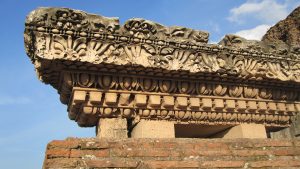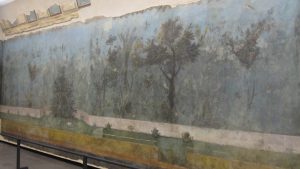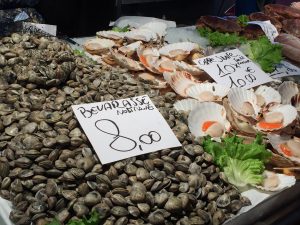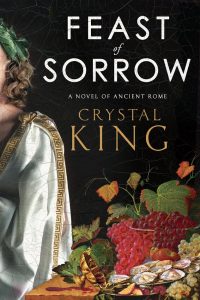Walk a Mile In Your Characters’ Shoes
“Write what you know.” Apparently, it was Mark Twain who gave this famous bit of advice, with which, to be honest, I don’t always agree. As a writer of historical fiction set hundreds and thousands of years past, it’s impossible to truly know what happened in those times. I don’t really know if all the research I’ve done is accurate.
I can look at a statue of an ancient Roman woman but don’t have any idea what the color of her stola was, or even the color of her hair. I fill in the gaps with my best guess, an educated one, but still a guess, yanked from my imagination.

Decoration that would have adorned Domitian’s Palace
That said, there is something to be said for walking in the footsteps of your character. My debut novel, FEAST OF SORROW, is set in first century Rome, in the time of Augustus and Tiberius.
My protagonist was a real person, an extraordinarily wealthy gourmand named Apicius. There is a wealth of information on the Net about the period of time in which my book is set, as well as countless books I can read on the subject. None of it can hold a candle to seeing the ruins of the Roman Forum up close, to see the size, the scale and the detail of the splendor that once was.
I have been to Rome six times in the last five years, researching everything I can to enhance my novels. Going to the Vatican Necropolis I learned that tombs of the wealthy had two floors–the bottom floor for holding the urns of cremated loved ones and the top floor was used by the living every year when they held a party for their ancestors.
During a later trip to the seaport town of Ostia Antica I had a chance to better see one of these two floored mausoleums. This detail drastically changed an entire scene I had written. My online and book research could not give me the perspective I needed to paint the picture accurately.

Frescoes from the Villa of Livia
My visits have enabled me to add all sorts of interesting things to the book to enhance the experience of the reader. In one scene I created tension by having my antagonist flaunt the fact he was able to hire the same fresco painters as the empress Livia. I could describe the frescoes because I had marveled at them up close.
It’s one thing to go to museums and see the artifacts of the places you are researching but it’s another to take tours or visit with historians who can help you see another side of the things you are seeing. Before my most recent trip to Rome I reached out to bestselling author Ian Caldwell to find out his strategy for researching the environs of the Vatican, as the book I’m currently working on is about a chef who worked for several Renaissance popes. Ian’s second novel, THE FIFTH GOSPEL, is set at the Vatican.
He was enormously helpful on a variety of levels but one of the best pieces of advice he gave me was to set up a private tour of the Vatican Gardens. He said the guides for that tour tend to be the most knowledgeable about the city itself. Going to the Library might prove tough since I’m not a scholar. A tour of the Museum would likely only land me with someone who is knowledgeable about art history. I booked the Garden tour and it turns out Ian was exactly right. My tour netted me with extremely valuable information and a contact that I can reach out to at anytime with questions I may have.
 Last year I visited Venice for the first time. I hadn’t desired to do so, convinced it was overrun by tourists. I thought I could get away with reading about the city and with a few spins around the streets via Google Streetview.
Last year I visited Venice for the first time. I hadn’t desired to do so, convinced it was overrun by tourists. I thought I could get away with reading about the city and with a few spins around the streets via Google Streetview.
Those of you who have been to Venice know how ridiculous of a notion that is. It is a city unlike any other. It is impossible. That it exists nearly defies logic. I know now I could not begin to paint a picture of the city–or the culture of its people–without having set foot there. To experience the closeness and darkness of the narrow calle, to hear the Venetian dialect, and to see and smell the Rialto market firsthand, there is no substitute.
In my travels, I have also found that people are enamored with authors and they want to help. When the proprietors of the little albergo I stay at learned I was a writer, they told me the hotel was the site of a Renaissance charitable guild, a factoid that is already worming its way into my story.
 If you are writing about a distant location, I highly recommend you find a way to visit, even if it has greatly changed since the time your story took place. I think you’ll find, as I have, that history is often still deeply woven into the fabric of the present, manifesting itself not just in the physical remnants but the culture and way of thinking of the people of today.
If you are writing about a distant location, I highly recommend you find a way to visit, even if it has greatly changed since the time your story took place. I think you’ll find, as I have, that history is often still deeply woven into the fabric of the present, manifesting itself not just in the physical remnants but the culture and way of thinking of the people of today.
Book tours, ask your hotel for references to local experts, and be curious when you are there. The color of your story will brighten and the details of your discoveries will make your writing pop and sparkle in a whole new way.
—
Crystal King is a 20-year marketing, social media and communications veteran, freelance writer and Pushcart-nominated poet. On April 25, 2017, Touchstone Books/Simon & Schuster published her debut novel, FEAST OF SORROW, about the ancient Roman gourmand, Apicius. Crystal has taught classes in writing, creativity, and social media at Harvard Extension School, Boston University, Mass College of Art, UMass Boston and GrubStreet writing center.
 A former co-editor of the online literary arts journal Plum Ruby Review, Crystal received her MA in Critical and Creative Thinking from UMass Boston, where she developed a series of exercises and writing prompts to help fiction writers in media res.
A former co-editor of the online literary arts journal Plum Ruby Review, Crystal received her MA in Critical and Creative Thinking from UMass Boston, where she developed a series of exercises and writing prompts to help fiction writers in media res.
Find her on Facebook at http://www.facebook.com/crystallynking, on Twitter at http://www.twitter.com/crystallyn, Instagram http://www.instagram.com/crystallyn14 or at her website:http://www.crystalking.com.
About FEAST OF SORROW
Set amongst the scandal, wealth, and upstairs-downstairs politics of a Roman family, Crystal King’s seminal debut features the man who inspired the world’s oldest cookbook and the ambition that led to his destruction.
On a blistering day in the twenty-sixth year of Augustus Caesar’s reign, a young chef, Thrasius, is acquired for the exorbitant price of twenty thousand denarii. His purchaser is the infamous gourmet Marcus Gavius Apicius, wealthy beyond measure, obsessed with a taste for fine meals from exotic places, and a singular ambition: to serve as culinary advisor to Caesar, an honor that will cement his legacy as Rome’s leading epicure.
Apicius rightfully believes that Thrasius is the key to his culinary success, and with Thrasius’s help he soon becomes known for his lavish parties and fantastic meals. Thrasius finds a family in Apicius’s household, his daughter Apicata, his wife Aelia, and her handmaiden, Passia whom Thrasius quickly falls in love with. But as Apicius draws closer to his ultimate goal, his reckless disregard for any who might get in his way takes a dangerous turn that threatens his young family and places his entire household at the mercy of the most powerful forces in Rome.
Category: Contemporary Women Writers, How To and Tips
Comments (5)
Trackback URL | Comments RSS Feed
Sites That Link to this Post
- Friday Finds for Writers | ErikaDreifus.com | December 9, 2016































Great ideas. Even if your book is set locally, as is mine, going to the place is very helpful. Walden Pond in Concord, MA is an important plot point in my current project and a delightful place to visit.
Great points! Imagination is no substitute for thorough research. This post made me more excited to read your book than I already was!
Great advice!
I’ve seen Venice in books and movies, but I agree that none of it compared to being there personally, taking the bus through the canals. Thanks for sharing your experiences!
This made me long to get back to Italy sooner than later! Thanks for sharing your insights, Crystal–can’t wait for your book!